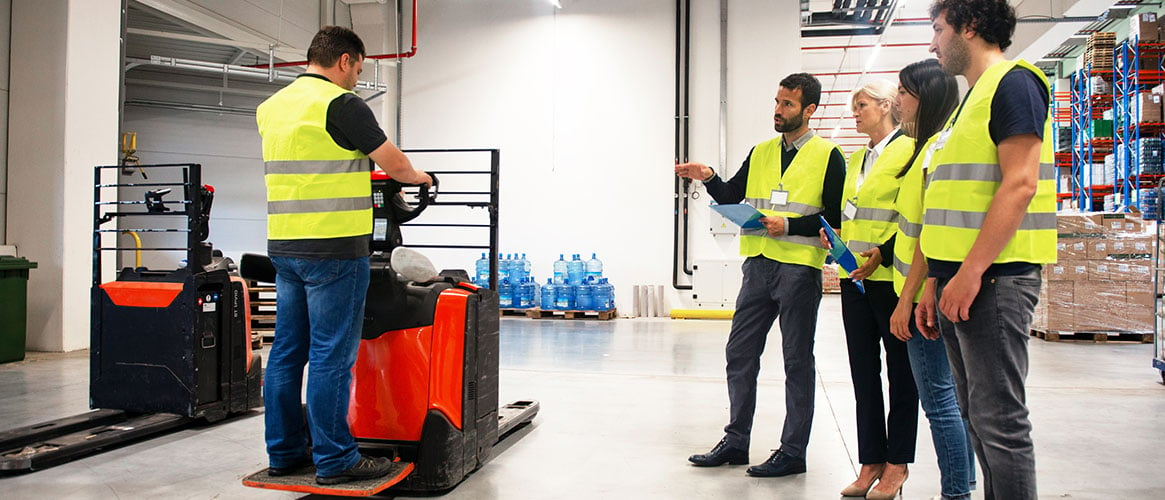In any workplace that involves loading, unloading, and stacking of large pallets or other heavy materials, there’s probably a forklift present. Each day, operators of these vehicles perform a balancing act—moving product from one location to another in a safe and efficient manner. However, that balance doesn’t always happen. In fact, most forklift-related injuries and deaths occur as a result of the vehicle tipping over—which often results in the driver being thrown from the forklift and becoming trapped underneath. Injuries also occur when the vehicle collides with another object, such as warehouse racks. In this case, inventory can come crashing to the ground, falling on top of the driver and others. And, if work is taking place on a loading dock, the forklift can fall off the dock to the ground several feet below.
What your employees need to know about using a forklift
Unsafe speed. Driving too fast is one of the most common causes of a forklift tipping over, especially when rounding a corner or taking a sharp turn. Many forklifts don’t have speedometers, but some may be equipped with governors to prevent the vehicle from exceeding a certain speed. Workers must know what the forklift is and is not equipped with and act accordingly to maintain a safe speed.
Carbon monoxide risk. If propane forklifts are in use, there’s a risk of carbon monoxide exposure. Should a CO monitor sound at the workplace or there is other evidence of an exposure, these forklifts must be shut down, a supervisor contacted, and the workplace cleared.
Balanced load. When the load being carried leans to one side or another or it’s too heavy, the load not balanced and neither is the forklift. This can lead to the vehicle tipping over. Weight limit information should be clearly labeled on the unit. If it’s not, then employees must bring that to your attention so it can be addressed.
Seatbelts. Just like driving a car, seatbelt use is critical. While some may consider it to be an inconvenience, especially if they need to enter and exit the forklift frequently, the seatbelt does protect them from being thrown from the vehicle and becoming trapped underneath.
What your employees need to do when using a forklift
All forklift operators must have employer authorization and be certified on how to operate the vehicle safely. Training is required prior to permitting an employee to operate a forklift and refresher training is required every three years. No one under the age of 18 may operate a forklift.
Other steps to follow include:
- Operate the forklift within the set speed limit as determined by management.
- Drive even slower when rounding corners, if the ground is slippery, or if pedestrians or other vehicles are present.
- Keep loads balanced.
- Plan the route and anticipate any turns along that route.
- Never turn on a grade, as a forklift can tip even on a small hill.
- Never turn with the forks elevated.
- Drive loaded forklifts forward while going up a ramp and in reverse when coming down.
- Do not perform any stunts.
- Consider using electric forklifts indoors instead of gas-powered ones.
- Report carbon monoxide exposures and other injury/illness risks to a supervisor.
Should a tip over occur, employees need to know how to protect themselves.
- Stay in the forklift. Never jump out. Jumping also can lead to a driver being struck by the rollover protection or trapped underneath a forklift. Since the operators are required to wear seatbelts, jumping should not be an option.
- Hold tight to the steering wheel.
- Brace feet.
- Lean forward and away from the impact.
What to cover at your safety meeting about forklifts
Review the amount of space available for operating forklifts, and discuss the challenges such as any uneven ground, inclines, or tight spaces.
Also, remind employees of the speed and weight limits and why they must follow them.
You might consider conducting demonstrations on how to operate forklifts safely, and include information on the consequences when operators drive too fast, perform stunts, or otherwise don’t follow the rules.
Discuss the training requirements and remind employees of the refresher training required every three years.
Remind your employees that when used properly, forklifts provide a quick and easy method to move inventory—no matter how heavy—to the intended location. When not used properly, forklifts can lead to serious and even tragic accidents.

